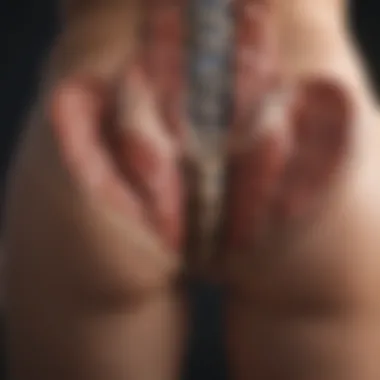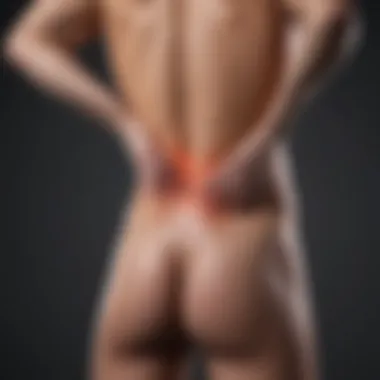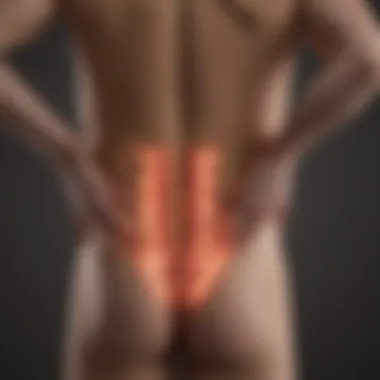Understanding Lower Back Pain: Medical Insights


Intro
Lower back pain is a universal affliction, impacting many individuals regardless of age or occupation. It brings with it not only physical discomfort but also complex emotional and social implications. Medical terminology around this condition is vital for numerous reasons, primarily for effective communication among healthcare professionals. Understanding the language used in this context enables better diagnosis and management of lower back pain. By dissecting medical terms, one can gain insights into the underlying causes, nature, and treatment options available.
The complexity of lower back pain is evident in its myriad of classifications. Terms such as "acute," "chronic," and "nonspecific" are commonly employed, each carrying specific implications regarding duration, severity, and treatment pathways. In order to foster a comprehensive understanding, this article will explore these terms in detail. It will also delve into the significance of precise vocabulary in both clinical settings and patient interactions.
Moreover, this writing intends to illuminate the key findings in the current discourse surrounding lower back pain, contributing both to academic literature and daily clinical practice. By thoroughly investigating terminology and its practical implications, the discourse aims to enhance clarity and understanding for students, researchers, educators, and professionals alike.
Each section will dissect the major results and methodologies, further stressing the relevance of this niche yet critical field in healthcare. Understanding the medical lexicon surrounding lower back pain ensures that discussions are not only informed but also impactful.
Prelude to Lower Back Pain
Lower back pain is a complex and multifaceted condition that can affect individuals of all ages. Understanding its significance is essential for both patients and healthcare professionals. The introduction to this discussion serves as a gateway into the nuances of lower back pain. It sets the stage for an exploration of its definitions, prevalence, and implications on daily life. By grasping these foundational aspects, one can appreciate the intricacies involved in diagnosing and treating this prevalent ailment.
Definition of Lower Back Pain
Lower back pain typically refers to discomfort or pain that occurs in the area between the rib cage and the gluteal folds. This pain can vary in intensity from mild to severe and may be acute or chronic. Acute pain often arises suddenly due to a specific injury or event, while chronic pain persists for three months or longer and may result from underlying conditions, including degenerative diseases.
The pain may involve various structures, such as muscles, ligaments, nerves, and discs. Accurate characterization of lower back pain is crucial because it can influence treatment choices. Many terms are used in clinical settings, such as "nonspecific lower back pain" when no identifiable cause is found, and it is important to differentiate these terms during diagnosis.
Prevalence and Impact
Lower back pain is one of the leading causes of disability worldwide. It affects millions of people and is often cited as a reason for missed work and decreased productivity. The World Health Organization emphasizes that approximately 60-70% of people experience lower back pain at some point in their lives.
The impact of lower back pain extends beyond physical discomfort; it can also affect mental health and quality of life. Individuals may experience anxiety or depression due to chronic pain, further complicating their recovery.
Research indicates that lower back pain often results in significant healthcare costs due to medical consultations, treatments, and rehabilitation. Therefore, understanding lower back pain is not merely academic but has practical applications in public health and healthcare delivery.
"Lower back pain is not just a symptom; it reflects larger personal and societal issues that necessitate comprehensive approaches to management."
Medical Terminology Related to Lower Back Pain
Understanding the medical terminology related to lower back pain is crucial for effective communication among healthcare providers and between patients and clinicians. Precise language helps in accurately diagnosing the condition and formulating appropriate treatment plans. It also aids in research, allowing for better categorization of findings and implications in studies related to back pain.
Clear medical language eliminates ambiguity, providing a consistent framework for discussing symptoms, causes, and interventions. As lower back pain is a prevalent issue affecting many individuals, grasping the terminology ensures that all parties involved can articulate concerns and solutions effectively.
Terminology Overview
In this section, we will survey the essential terms one must know when navigating discussions around lower back pain. This includes both anatomical and pathophysiological terms, which frame our understanding of the condition's complexity.
Anatomical Terms
Lumbar Region
The lumbar region is a key anatomical area when considering lower back pain. This part of the spine consists of five vertebrae, labeled L1 through L5. The lumbar spine supports much of the body’s weight and is essential for movement. Its flexibility allows for bending and twisting, important for daily activities.
Key characteristic of the lumbar region is its ability to handle both load and movement. This dual function means that it is particularly susceptible to injuries and degenerative changes, making it significant in discussions about lower back pain. A unique feature of the lumbar region is its broad intervertebral discs, which help cushion and absorb shock. However, this can also lead to common issues like disc herniation and lower back pain.
Vertebral Anatomy
Vertebral anatomy encompasses the structure of the vertebrae and the surrounding components like the spinal cord and nerves. Each vertebra consists of a body, arch, and processes that provide attachment for muscles and ligaments. Understanding the anatomy of vertebrae helps in diagnosing conditions such as fractures or degenerative disc diseases.
Key characteristic is the interlocking design that allows stability while permitting movement. An important unique feature is the spinal canal, which houses the spinal cord; its integrity is vital for neurological function. Damage in this area can lead to significant complications, including pain and loss of mobility.
Surrounding Structures
The structures surrounding the lumbar spine include ligaments, muscles, and nerves. These components play critical roles in the support and function of the lower back. Ligaments stabilize the spine, while muscles facilitate movement.
Key characteristic is their interconnectedness; an issue in one area often influences others. For example, a strained muscle may also affect nerve function, leading to radicular pain. Unique features like the sacroiliac joint play a role in transferring weight and movement between the spine and pelvis, influencing overall lower back pain dynamics.


Pathophysiological Terms
Disc Herniation
Disc herniation occurs when the inner gel-like core of an intervertebral disc protrudes through the outer layer. This can exert pressure on nearby spinal nerves, causing pain, numbness, or weakness in the legs. Understanding disc herniation is essential, as it is a common source of lower back pain.
Key characteristic is its ability to occur suddenly or develop over time due to wear and tear. One unique feature is that not all herniations cause symptoms; some individuals may not experience discomfort despite the condition.
Radiculopathy
Radiculopathy describes pain that radiates along the nerve due to pressure on a nerve root in the spine. This condition often results from herniated discs or bone spurs that compress nerves. Addressing radiculopathy is critical since it illustrates how spinal conditions can manifest as pain in areas away from the source.
Key characteristic is the range of symptoms, which can include tingling or weakness. A unique feature of radiculopathy is its potential for self-resolution, though some cases may require surgical intervention if conservative treatments fail.
Spondylosis
Spondylosis refers to the degenerative changes in the spine often attributed to the natural aging process, including osteoarthritis. This condition can lead to stiffness, pain, and decreased mobility in the lower back. Recognizing spondylosis contributes to understanding chronic lower back pain presentations.
Key characteristic is its progressive nature, which can often be managed but not entirely reversed. A unique aspect of spondylosis is its prevalence among older adults, making it a common diagnosis in clinical settings for lower back issues.
Classifications of Lower Back Pain
Classifying lower back pain is crucial. It helps healthcare professionals diagnose and create appropriate treatment strategies. Understanding these classifications gives insights into the nature of pain, its origin, and how to approach recovery. Dividing pain into categories allows tailored management plans that can improve patient outcomes.
Acute vs. Chronic Pain
Acute pain is typically defined as pain lasting less than three months. This type of pain often arises from a specific injury or event, such as a fall or lifting something heavy. Acute pain usually resolves as the body heals. It may respond well to conservative treatments like physical therapy and medications.
Chronic pain, on the other hand, persists beyond the expected healing time. It may last more than three months and can be a complex condition. Chronic pain often involves ongoing discomfort resulting from injuries, medical conditions, or psychological factors. Managing chronic pain requires a multifaceted approach. It often includes long-term rehabilitation, psychological support, and sometimes surgical interventions.
Key Differences Between Acute and Chronic Pain:
- Duration: Acute lasts short-term; chronic lasts long-term.
- Causes: Acute is due to specific injuries; chronic may arise from various factors.
- Treatment Response: Acute pain often improves with standard treatments; chronic may require more advanced management.
A significant difference between acute and chronic pain affects treatment choices. Understanding which type of pain a patient experiences informs the decision-making process.
Mechanical vs. Non-Mechanical Pain
Mechanical pain arises from structures within the spine. These may include vertebrae, discs, or surrounding muscles. It often results from movement. Common mechanical pain causes include muscle strains, disc herniation, and facet joint issues. Patients typically experience stiffness or soreness, and the pain may increase with certain movements.
Non-mechanical pain, however, does not originate from the spine itself. Conditions such as infections, fractures, or inflammatory diseases can lead to non-mechanical lower back pain. It might not necessarily relate to movement or physical activity. Identifying if pain is mechanical or non-mechanical is crucial for correct diagnosis and treatment.
Characteristics of Mechanical and Non-Mechanical Pain:
- Mechanical Pain:
- Non-Mechanical Pain:
- Responsive to movement.
- Can be localized to a specific area.
- Often related to muscle or joint issues.
- Often diffuse or widespread.
- Does not depend primarily on movement.
- May indicate more serious underlying conditions.
Understanding these classifications contributes significantly to an accurate diagnosis and effective treatment plan for lower back pain.
Etiology of Lower Back Pain
Understanding the etiology of lower back pain is crucial for both diagnosis and management. The term 'etiology' refers to the study of causation. By identifying the underlying causes of lower back pain, healthcare providers can tailor treatment strategies to address the specific sources of discomfort. This section will explore common causes and relevant risk factors, allowing clinicians and patients to gain a better understanding of this multifaceted issue.
Common Causes
Lower back pain can arise from various origins, each with distinct characteristics. Some main causes include:
- Muscle Strain: Often the result of heavy lifting or sudden awkward movements. Muscles may become overstretched, leading to pain and limited mobility.
- Herniated Discs: Discs may bulge or rupture, pressing on nearby nerves. This can cause sharp pain, tingling, or numbness, especially in the legs.
- Arthritis: Conditions like osteoarthritis can affect the vertebrae in the lower back, resulting in pain and stiffness.
- Skeletal Irregularities: Issues such as scoliosis can lead to uneven stress on the back, contributing to chronic pain.
- Infections or Tumors: Though less common, these serious conditions can cause lower back pain and require immediate medical attention.


A comprehensive understanding of these causes aids in forming effective strategies for treatment.
Risk Factors
Various risk factors can increase an individual's likelihood of experiencing lower back pain. These factors can be categorized into occupational risks, lifestyle factors, and genetic predispositions.
Occupational Risks
Occupational risks hold a significant role in the etiology of lower back pain. Jobs that require heavy lifting, prolonged sitting, or repetitive motions greatly increase the risk.
- Key Characteristic: Jobs in construction, nursing, and manufacturing frequently expose individuals to situations that strain the back.
- Beneficial Choice: Highlighting these risks helps prevention strategies in workplace settings.
- Unique Feature: Ergonomics can be enhanced through proper training and tools, reducing the incidence of back injuries.
Lifestyle Factors
Lifestyle choices are another crucial aspect when considering lower back pain. Factors such as poor diet, lack of exercise, and obesity contribute significantly to the risk.
- Key Characteristic: Sedentary lifestyles correlate with weaker muscles and less support for the spine.
- Beneficial Choice: Encouraging active lifestyles can reduce pain risks, ultimately improving overall health.
- Unique Feature: Simple changes, such as regular exercise and maintaining a healthy weight, can make a substantial difference in lower back pain incidence.
Genetic Predispositions
Genetic factors can also influence the likelihood of developing lower back pain. Certain families may exhibit a higher prevalence.
- Key Characteristic: Individuals with a family history of back disorders may be at greater risk.
- Beneficial Choice: Understanding these predispositions aids in early identification and proactive measures.
- Unique Feature: Genetic risks combine with other factors; awareness can foster better lifestyle adjustments and preventive care.
Diagnostic Approaches
Diagnosis of lower back pain requires careful assessment and appropriate imaging techniques. Accurate diagnosis facilitates targeted treatment, which is critical for effective management of this complex condition. This section discusses the significance of clinical assessments and various imaging techniques in diagnosing lower back pain. The integration of these approaches is essential for establishing a stable foundation for patient care, guiding treatment decisions, and understanding long-term outcomes.
Clinical Assessment
Clinical assessment is the first step in diagnosing lower back pain. It involves detailed patient history and physical examinations to gather relevant information. During this process, clinicians evaluate the patient’s symptoms, including the nature, duration, and severity of the pain. They also consider whether the pain is sharp, dull, constant or intermittent. Additionally, it is crucial to assess any previous treatments and their effectiveness.
Physical examination techniques may include checking the range of motion, observing posture, and assessing strength and reflexes. This evaluation helps in identifying specific conditions that may contribute to lower back pain, such as muscle strain, herniated disc, or degenerative disorders. Clinicians may utilize standardized questionnaires to evaluate disability and quality of life, providing further insights into the patient’s condition.
This thorough assessment is vital, as it helps differentiate between mechanical and non-mechanical pain. Knowing this distinction can direct the course of treatment effectively.
Imaging Techniques
Imaging techniques are essential to visualize spinal anatomy and detect pathological changes. Diagnostic imaging enhances the understanding of a patient’s condition and guides clinical decisions. Here are the primary imaging techniques used:
MRI
Magnetic Resonance Imaging (MRI) is often considered the gold standard in imaging for lower back pain. The key characteristic of MRI is its ability to produce detailed images of soft tissues. This feature allows clinicians to assess spinal discs, nerves, and surrounding structures without using ionizing radiation.
A major advantage of MRI is its sensitivity to detect conditions like disc herniation and spinal tumors. However, it can be expensive and may not be readily available in all medical facilities.
CT Scans
Computed Tomography (CT) scans also play a significant role in diagnosing lower back pain. CT scans combine multiple X-ray images to create cross-sectional views of the body. This technique gives a comprehensive view of bone structures and can reveal fractures or abnormalities that may not be visible on traditional X-rays.
The benefit of CT scans lies in their speed and availability in most healthcare settings. However, patients are exposed to a higher dose of radiation compared to MRI, which is a drawback for its use.
X-Rays
X-rays are a commonly used imaging technique for lower back pain. They are particularly effective for visualizing bone structure and can help identify fractures or signs of degenerative changes, such as arthritis. The key characteristic of X-rays is their accessibility and rapid turn-around time for results.
Despite their advantages, X-rays have limitations as they do not provide clear images of soft tissues. Therefore, they are often used as a preliminary step before further imaging techniques like MRI or CT scans.
In summary, diagnostic approaches involving clinical assessment and imaging techniques are instrumental in understanding lower back pain. They ensure accurate diagnosis and appropriate management.


Treatment Modalities
Treatment modalities for lower back pain encompass a spectrum of options aimed at alleviating pain and restoring function. Each modality serves an essential role in managing the complexities of this condition. By understanding different treatment strategies, patients and healthcare providers can make informed decisions tailored to individual needs. This section explores various approaches including conservative treatments and interventional procedures.
Conservative Treatments
Physical Therapy
Physical therapy plays a crucial role in the management of lower back pain. It focuses on improving strength, flexibility, and overall function of the musculoskeletal system. One key characteristic of physical therapy is its tailored approach, allowing therapists to customize interventions based on a patient’s specific condition and capabilities. This adaptability makes it a beneficial choice for many suffering from lower back pain.
A unique feature of physical therapy is the combination of exercises and manual techniques designed to restore motion and reduce pain. Its advantages include the promotion of self-management and prevention strategies that may lead to long-term pain relief. However, it requires consistent commitment from the patient, and results may vary.
Medication Management
Medication management is another essential aspect in treating lower back pain. This includes various pharmacological strategies to control pain and inflammation. The key characteristic of medication management is the use of both over-the-counter and prescription drugs, providing flexibility in addressing varying pain levels.
The unique feature of medication management is its ability to offer quick relief for acute episodes. Non-steroidal anti-inflammatory drugs (NSAIDs) and analgesics are commonly used to manage discomfort. Yet, there are risks associated with long-term use, such as dependency and side effects, which need consideration in treatment planning.
Interventional Procedures
Injections
Injections serve as a targeted treatment modality for lower back pain. Commonly used for persistent pain, this procedure delivers anti-inflammatory medication directly to the affected area. The primary characteristic of injections is the immediate localized relief they can provide, which can enhance quality of life significantly.
A unique advantage of injections is their ability to serve as both a diagnostic and therapeutic tool. While they can alleviate pain temporarily, the potential drawback lies in the short-lived effects, necessitating repeat procedures for lasting results.
Surgery Options
Surgical options are considered for patients who have not responded to conservative and interventional treatments. These procedures aim at addressing structural issues within the spine. The defining characteristic of surgery is its potential to provide definitive relief by correcting underlying problems, such as herniated discs or spinal stenosis.
A unique aspect of surgical interventions is their varying complexity, from minimally invasive techniques to more extensive operations. While they can lead to substantial improvements, surgery carries inherent risks and requires thorough discussion between patient and physician.
Rehabilitation and Recovery
Rehabilitation and recovery play an essential role in the management of lower back pain. Both processes are crucial to restoring function and minimizing the risk of recurrence. This section will explore specific elements, benefits, and important considerations surrounding rehabilitation and recovery.
Importance of Rehabilitation
Rehabilitation is important for several reasons. First, it addresses the underlying causes of pain. A thorough program helps to identify weaknesses in muscles or issues with joint mobility. By focusing on these elements, rehabilitation can promote healing, strengthen key areas, and enhance overall function.
Moreover, rehabilitation aids in pain management. By employing targeted exercises and techniques, individuals can experience reduced pain levels over time. Techniques may include physical therapy, which involves guided exercises tailored to individual needs, or manual therapy to alleviate discomfort. Rehabilitation fosters a sense of empowerment, allowing patients to take an active role in their recovery.
The continued commitment to rehabilitation is vital for the long-term success of any treatment strategy. Engaging in a structured rehabilitation program can encourage positive lifestyle changes, discourage sedentary behavior, and improve overall health.
Long-term Management Strategies
Long-term management strategies are crucial for sustaining recovery from lower back pain. These strategies can help prevent future episodes and maintain quality of life. Here are a few effective approaches:
- Physical Activity: Consistent participation in low-impact aerobic exercises, such as walking, swimming, or cycling, can be beneficial. Exercise strengthens muscles and improves flexibility, thereby supporting the spine.
- Education: Understanding body mechanics and ergonomic principles is important. Patients should learn how to lift objects correctly and maintain proper posture, especially during daily activities or work.
- Regular Follow-ups: Periodic follow-up appointments with healthcare providers can help monitor progress and adapt strategies as necessary.
- Pain Management Techniques: Employing non-invasive methods, such as heat or cold therapy, alongside prescribed medications can facilitate pain control.
- Mindfulness and Stress Management: Integrating practices like yoga or meditation can help manage stress, which is often a factor in pain perception.
Recovery from lower back pain is a continuous process. Engaging in rehabilitation and implementing long-term management strategies can significantly improve outcomes.
Epilogue
The conclusion of this article is essential as it encapsulates the main insights derived from the discussions on lower back pain. Understanding the medical terminology surrounding this condition is crucial for both professionals and patients. By recognizing specific terms and their implications, individuals involved in patient care can make more informed diagnoses and treatment decisions.
Summary of Key Points
In summary, lower back pain is a multifaceted issue that encompasses various medical terminologies. It is classified into categories such as acute, chronic, mechanical, and non-mechanical pain. Common causes include muscle strains and disc problems. Diagnostic approaches, encompassing clinical assessment and imaging techniques, play a significant role in understanding the patient's condition.
Moreover, treatment options range from conservative methods, like physical therapy, to more invasive procedures, like surgery. Rehabilitation is vital for long-term recovery, emphasizing the need to adopt effective management strategies post-treatment.
Future Directions in Research
Looking ahead, future research on lower back pain should focus on a few key areas. First, studies exploring the efficacy of emerging treatments, such as regenerative medicine and innovative rehabilitation techniques, are necessary. Furthermore, understanding the role of genetics in predisposing individuals to lower back pain could offer new preventive strategies.
Additionally, continued exploration of the psychosocial aspects of pain will provide insight into the patient experience, which is critical for developing comprehensive care plans. The integration of technology, such as telehealth solutions, may also enhance how practitioners manage and treat lower back pain in various populations.



